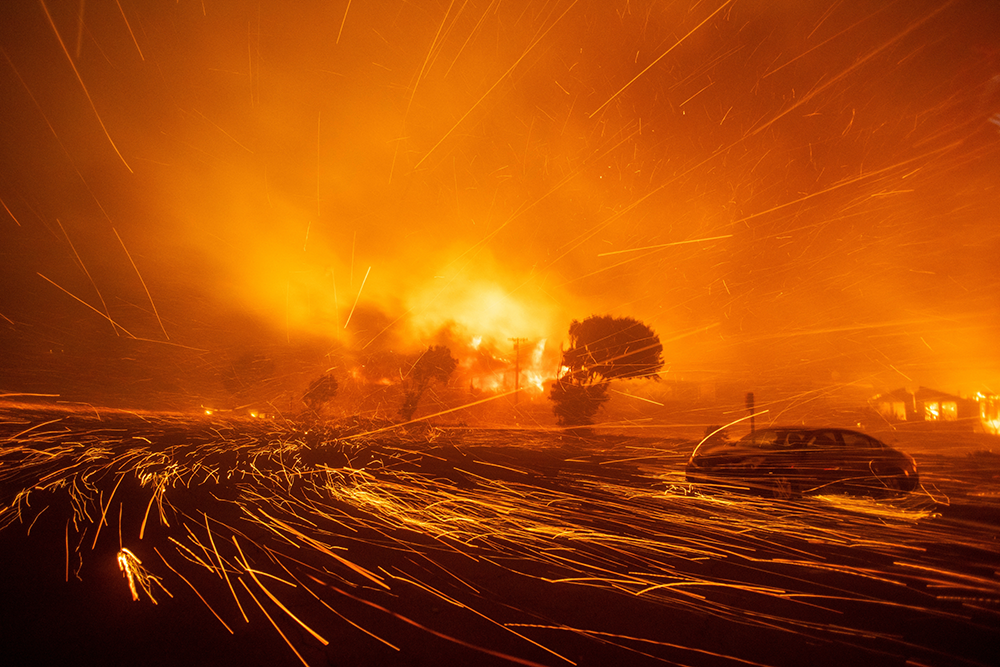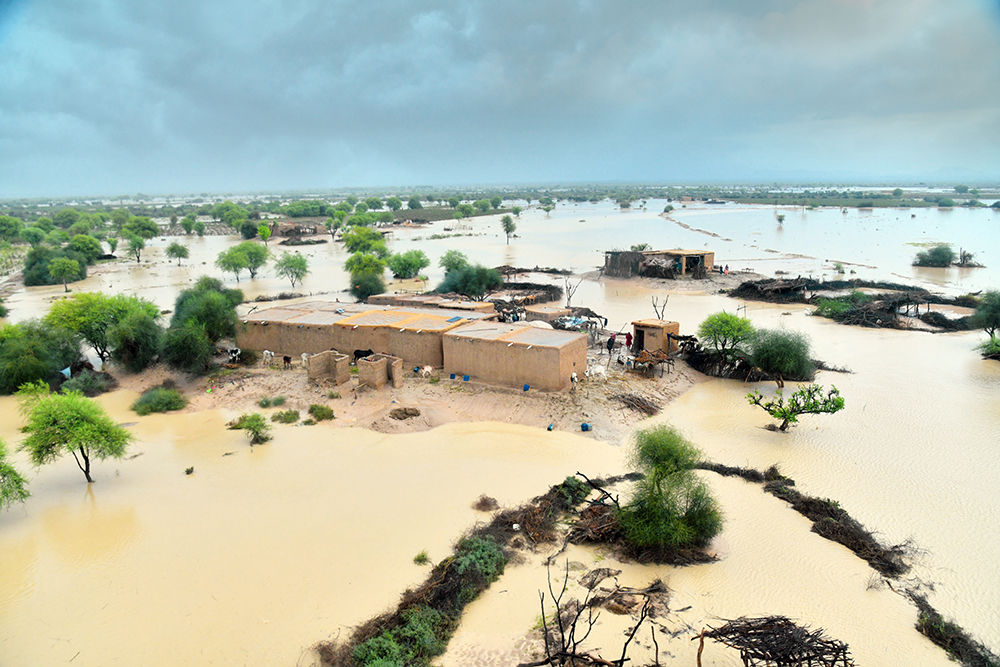Writing by the Director
POSTED ON: March 13, 2025
The Hidden Cost of Climate Change
It has been a tumultuous month since the devastating fires in Los Angeles. In a media-saturated world where attention is a capricious commodity, it is easy to forget the cost and various causes of this tragedy and what it means for the world. Some have lamented the perils of human error, others on the limitations of infrastructural design to counter simultaneous conflagrations. Still, more emphasis on investing in the health of the planet and the unseen cost of divesting from Climate Change adaption and aid is necessary. The urgency of the climate crisis cannot be overstated, and immediate action is imperative.
Unfortunately, the future is not fungible, and the systemic effects of climate change are difficult to measure in terms of immediate or short-term return on investment. The interconnectedness of climate systems, where various factors interact over vast scales of time and space, makes it challenging to isolate the specific impact of a single human activity on climate change and its subsequent effects. These processes often involve feedback loops where a change in one element can amplify or counteract another, adding to the issue's complexity, otherwise known as the poly-crisis.

After studying ninety extreme weather events worldwide, a team of thirty-two researchers, composed of leading wildfire scientists from the US and Europe, as part of the reputable World Weather Attribution project, concluded that Climate Change led to a 35% increased chance that the fires of 2025 in LA would occur. The overlap of hurricane-force Santa Ana winds and flammable seasonal drought conditions contributed to the ferocity of climate-enabled LA fires. Desiccated landscapes and drier air are sharpened by human-driven factors that often accelerate climate change and the propensity for extreme weather patterns.
One of the scientists, Dr Clair Barnes, stated, “Without a faster transition away from planet-heating fossil fuels, California will continue to get hotter, drier, and more flammable.”
According to UCLA (Yi, Liu, Feb 4, 2025), “…the total property and capital losses of the Los Angeles fires range between $95 billion and $164 billion, with insured losses estimated at $75 billion... In addition, there is a total wage loss of $297 million for local businesses and employees in the affected areas.” It is difficult at this point to measure the long-term ecological impacts and impact on air quality due to the toxic pollutants like ash, chemicals, and heavy metals from burning structures and vehicles, which can exacerbate respiratory issues like asthma and cause other health concerns for residents, particularly those with pre-existing conditions. These particulates can travel vast distances and even change the hue of skylines, visually reminding us that Climate Change is an apolitical and inexorable actor.
Indeed, UCLA further expands; unfortunately, “…without substantial and effective wildfire mitigation efforts and investments, Californians will face increasingly higher insurance premiums and growing health risks from wildfire-related pollution.” L.A. rental housing markets may become increasingly unaffordable, and architectural and infrastructure measures and environmental management will need to evolve. The story of California has a similar plotline across the globe: the 2022 floods in Pakistan, extreme urban heat in the Middle East, sharper droughts in Sub-Saharan Africa, stronger and more frequent hurricanes in the Atlantic, and greater atmospheric instability in many coastal and inland regions. These are, in turn, powerful hidden drivers of economic and livelihood migration- with substantial local and global financial implications.
Many vulnerable communities, cities, and indeed countries do not have adequate resources to address the costs of Climate Mitigation (let alone Adaptation), and aid, green investment, and various forms of climate-based partnerships have played a part in bringing communities closer toward nature-positive practices, economic growth, and net zero ecosystems. This underscores the urgent need for global cooperation in addressing climate change through various means. However, the social contract between wealthy states (frequently the highest per capita carbon emitters) and climate-vulnerable communities (often the lowest per capita carbon emitters) is under increased contestation and has been at its lowest point in decades.
The fingerprint of climate change is often at the crime scene of aid dilemmas, such as large-scale refugee crises, infectious diseases, conflicts over food and/or mineral security, or environmental collapse (to name a few). Ancillary pressures, such as inflation, highly indebted economies, slow and unequal growth, a decline in GDP (per capita), and donor country identity politics, have also put more significant pressure on aid budgets.
Various innovative approaches to prioritize aid allocation are required to leverage existing resources more efficiently. To foster strong partnerships between donor countries, international organizations, and local communities to address urgent needs while managing budgetary constraints, effectively requires a deeper appreciation of the cost of inaction and creating novel forms of finance. This transition portends an unraveling of the familiar aid model potentially in favor of investment and bolstering local capacity to circumvent dilemmas and their causes. However, it is unlikely that the delta between aid and finance has been sufficiently mapped in size or character or correlated to the hidden costs of insufficient action on Climate Change. Whilst the ostensible purpose of aid has historically been to stimulate growth, this growth needs to be coupled with ecological renewal to de-risk the future from adversarial and ultimately costly environmental conditions.
This unraveling of the global Aid landscape is underscored by the fact that in 2024, over seventy countries (well over half the Earth’s population) held national elections, and many wealthy countries are resetting their priorities in varying shades of non-systemic national interests. Some features include higher transactional impulses from donors and less emphasis on adherence to social virtues, such as observance of human rights, free and fair elections, eradication of state-sanctioned violence, war-mongery, etc. 2025 is a critical geopolitical inflection point that demands immediate attention, action, and awareness; this unraveling may lead to reduced urban resilience and divestment from climate-smart capital and lead to statistical acceleration toward extreme weather patterns and human-based conflict over livelihood resources such as water, minerals, productive soil, etc. This directly impacts the development and aid landscape and how actors adjust accordingly. Aid effectiveness, measured in terms of communities or countries graduating from aid dependency, has been a crude yardstick to measure progress. Despite the lack of consensus on what constitutes effective aid deployment, it ignores the reality that development cooperation has been essential for growth within and between countries, without exception.

Until recently, the US accounted for 42% of global humanitarian spending. In some areas, such as HIV-AIDs prevention and treatment, $5.4bn (2024) in annual spending (97% for overseas programs), over 25% of the global budget, primarily driven by USAID. Risks, such as economic precarity, governance challenges, and ecological change, affect food security, conflict, and economic migration are growing. If unchecked, these risks can devolve into shocks, such as resource-based conflict, environmental collapse, zoonotic contamination, and political distress. Other shocks can and must include the macroeconomic implications caused by the shunting of international aid or programs as the political priorities of nations and partners evolve toward transactional bilateralism, away from multilateral values-based aid.
Important programs face abrupt disruption due to lacking funding and are likely forced to scale back services or close them altogether. Local governments already struggling to fulfill unmet needs in critical service sectors, such as access to antiretrovirals for HIV/AIDS patients or essential training and resources for teachers in heavily underfunded schools, will feel the highest impact of these disruptions. Many of these local and international NGOs have little choice but to de-fund initiatives to strengthen civil society or hold governments accountable since their maximum priority is keeping fieldwork supported by external funding afloat. There are sudden and widespread issues arising from the disappearance of funding that will severely impact all facets of development work. Yet, many of these issues are faced primarily by smaller organizations and communities. Despite the localized nature of these impacts, many nations are equally entangled in the churning sea of modern global capital flows and competing and increasingly narrow national interests.
What’s next?
Maintaining a course toward Nature-Positive economic growth and bioeconomic practices that support local resilience and livelihoods is essential. Calibrating aid consensus toward net-zero principles and the 2030 Sustainable Development Goals will better address inclusive development's systemic implications and witness an improved social contract between People, Planet, and Prosperity (3P). Cities and Carbon markets (voluntary and compliance) have a role, as do new forms and channels of capital flow to shore up the breach created by retreating aid models and coarse macro-economic nativism.
Without this, extreme weather patterns will render livelihoods untenable and trigger a growing cascade of economic and environmental shocks that will sharpen the poly-crisis of our time.
That is a Future we can avoid.
Mokena Makeka, Architect/urbanist
Founding partner, AXUM/
Director of the Civic Projects Lab, The Cooper Union.Makeka Design Lab
Credit to:
https://science.nasa.gov/wildfires-and-climate-change/
https://3news.com/opinion/bright-simons-why-the-crisis-in-global-aid-is-bigger-than-trump/




